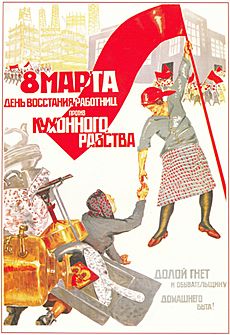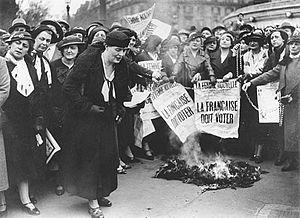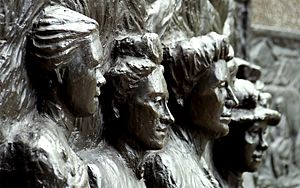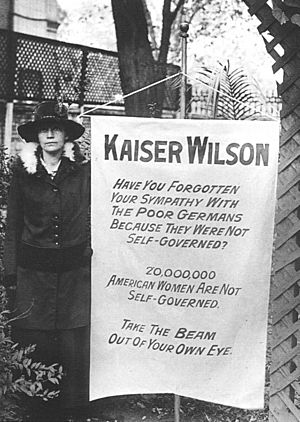First-wave feminism facts for kids
First-wave feminism was a big movement that happened in the 1800s and early 1900s, mostly in Western countries. It was all about getting women more legal rights, especially the right to vote.
The name "first-wave feminism" was first used by a journalist named Martha Lear in 1968. This wave focused on women gaining political power, like the right to vote, rather than unofficial inequalities. While we use the idea of "waves" to describe feminism, some people say it doesn't fully show all the activism that happened before and during this time.
Contents
- What Was First-Wave Feminism?
- The Importance of Education
- First-Wave Feminism Around the World
- Argentina's Movement
- Australia's Fight for Rights
- Canada's Path to Equality
- Denmark's Progress
- France's Revolutionary Ideas
- Germany's Collective Goals
- The Netherlands' Campaigners
- New Zealand's Early Success
- Russia's Women's Movement
- Sweden's Path to Suffrage
- Switzerland's Long Struggle
- United Kingdom's Campaigns
- United States' Movement for Suffrage
- Key Dates in First-Wave Feminism
What Was First-Wave Feminism?
Movements to expand women's rights started long before the 1900s. For example, Christine de Pizan wrote about defending women in the 1400s. Other early thinkers like Heinrich Cornelius Agrippa and Modesta di Pozzo di Forzi also worked on these ideas in the 1500s.
Mary Wollstonecraft: A Pioneer
Mary Wollstonecraft was an important writer during the Age of Enlightenment. This was a time when many new ideas about society and government were being discussed. However, women were often left out of these important talks.
Wollstonecraft believed that society should be based on gender equality. She wrote a famous book called A Vindication of the Rights of Woman in 1792. In this book, she argued that boys and girls should have the same opportunities for education. She thought that if women were better educated, they could play a bigger role in public life.
Wollstonecraft's ideas were very bold for her time. She is seen as a "fore-mother" of the British feminist movement. Her thoughts helped shape the ideas of the suffragettes, who later fought hard for women's right to vote.


The Importance of Education
Education was a key focus for first-wave feminists. They believed that educating young women was vital for them to understand their full potential. Many people in the 1960s and 70s thought women's main role was to have children. Suffrage movements wanted young women to know there was more to life than that.
For example, in the UK, only about 25% of full-time university students were female in the 1960s. By 2013, this number had grown to 54% female students. This big increase shows how the women's suffrage movements helped encourage women to go to school and get higher education. In Switzerland, women gained the right to vote in 1971, which helped open doors for more educational opportunities.
First-Wave Feminism Around the World
The first wave of feminism happened in many countries, with women fighting for similar rights.
Argentina's Movement
In the late 1800s and early 1900s, women in Argentina created a strong feminist movement. They often worked with labor movements and included socialists, anarchists, and educators. In May 1910, they held the First International Feminist Congress. Many famous thinkers from around the world discussed ideas about gender, political rights, education, and health.
Australia's Fight for Rights
In Australia, Rose Scott, a women's rights activist, started holding meetings in her Sydney home in 1882. These meetings brought together important politicians and writers. She helped create the Womanhood Suffrage League in 1891. This group worked to pass laws like the Early Closing Act of 1899, which helped working women.
Canada's Path to Equality
Canada's first wave of feminism began in the late 1800s. Women started by raising awareness and forming study groups, then took action by creating committees. Education was a top priority. In 1865, Egerton Ryerson, an Ontario school superintendent, pointed out that girls were excluded from education. Over time, more girls attended school and even surpassed boys in graduation rates. By 1880, 51% of high school graduates in British Columbia were female.
Canadian feminists also focused on voting rights, labor rights, and health rights. They joined international groups like the International Council of Women. Women realized they would be more powerful if they worked together.
Denmark's Progress
The first women's movement in Denmark was led by the Danish Women's Society, founded in 1871. Important women like Line Luplau and Tagea Brandt were part of this movement. Their efforts led to a new Danish constitution in 1915, which gave women the right to vote. Laws in the 1920s also gave women equal access to education, work, and marital rights.
France's Revolutionary Ideas
Discussions about women's rights happened during the French Revolution. Some progress was made with new inheritance laws and the right to divorce. Groups like the Society of Revolutionary Republican Women pushed for gender equality in politics. They worked to increase economic opportunities for women through meetings and journals.
However, the Napoleonic Code of 1804 removed much of this progress. Women's rights were supported again during the short rule of the Communist Paris Commune in 1870. A newspaper called La Fronde, run by women, also covered important topics like working women's rights. The organized movement began in 1870 with the Association pour le Droit des Femmes.
Germany's Collective Goals
Germany's first women's movement started around the European Revolutions of 1848. The first women's organization, the Allgemeiner Deutscher Frauenverein (ADF), was founded in 1865. Middle-class women wanted to improve their social status and be respected as individuals. They joined political struggles, hoping for full equality. Their goals included gaining rights to work, education, and professions. German feminism focused on the common good and social justice. This pressure led to women gaining the right to vote in the early 1900s.
The Netherlands' Campaigners

Even though ideas about equality for women and men grew in the Netherlands during the Age of Enlightenment, not much changed legally. But in the late 1800s, many feminist groups started.
Aletta Jacobs was the first woman in the Netherlands to study at a university in 1871. She became the first female doctor and spent her life fighting for women's right to vote, equal rights, and peace. Wilhelmina Drucker was another important activist who helped women gain the right to vote in 1917–1919.
New Zealand's Early Success
New Zealand had early feminists and suffragettes like Kate Sheppard and Mary Ann Müller. In 1893, Elizabeth Yates became the first female mayor in the entire British Empire. New Zealand was also the first self-governing country where all women could vote in national elections.

Russia's Women's Movement
Before 1905, it was not legal to form political groups in Imperial Russia. However, women still worked for their rights. In the mid-1800s, women like Anna Filosofova and Maria Trubnikova formed literary clubs. These clubs discussed Western feminist ideas and became the first unofficial women's rights groups in Russia.
After the Crimean War, Russia started reforms, including opening schools for girls. The women's clubs pushed for women to attend university courses, which became very popular. In 1895, Anna Filosofova founded the "Russian Women's Charity League." This group was officially for charity, but it was really a women's rights organization.
After the 1905 Russian Revolution, political groups became legal. The women's movement then formed the Liga ravnopraviia zhenshchin and campaigned for women's right to vote. The Russian Revolution of 1917 made men and women equal by law in the Soviet Union.
Sweden's Path to Suffrage
In Sweden, discussions about women's rights happened in the 1700s, but no organized movement formed then. The first person to speak publicly for feminism was Sophie Sager in 1848. The first organization to deal with a women's issue was for retired female teachers in 1855.
A famous book called Hertha by Fredrika Bremer in 1856 caused a big debate. It led to unmarried women gaining the right to manage their own affairs in 1858 and a "Women's University" being founded in 1861. The first women's magazine in the Nordic countries, Tidskrift för hemmet, was started in 1859.
The organized women's movement began in 1873 with the Married Woman's Property Rights Association. In 1884, the Fredrika Bremer Association was founded to improve women's rights. Finally, in 1902, the National Association for Women's Suffrage was created. Women gained the right to vote in 1919-1921. After that, a law in 1923 gave men and women equal access to almost all jobs and positions in society.
Switzerland's Long Struggle
The Swiss women's movement started after the Constitution of 1848, which did not include women's rights. The movement faced challenges because of language differences between French and German-speaking areas. However, Marie Goegg-Pouchoulin founded the first international women's movement, the Association Internationale des Femmes, in 1868.
The first national women's organization, the Schweizer Frauen-Verband, was founded in 1885. Later, the Schweizerischen Gemeinnützigen Frauenverein (SGF) became a main group for the Swiss women's movement. Groups like the Schweizerischer Frauenvereine and the Schweizerischer Verband für Frauenstimmrecht pushed for women's right to vote.
Swiss women finally gained the right to vote in national elections on October 31, 1971. Their success was affected by how well they could organize, their money, and their alliances with other political groups.
United Kingdom's Campaigns
Early feminist reformers in the UK were not always organized. Individuals like Caroline Norton, who couldn't get a divorce or see her children, campaigned for change. Her efforts led to the Custody of Infants Act 1839, which gave divorced mothers some rights to their children.
The first organized movement was the Langham Place Circle in the 1850s. This group, including Barbara Bodichon and Bessie Rayner Parkes, campaigned for better female rights in jobs, education, and property. They helped pass the Married Women's Property Act 1882, which gave women control over their own earnings and property. They also started the first British feminist newspaper, the English Woman's Journal.
During World War I, more women worked outside the home. This led to the Sex Disqualification (Removal) Act 1919, which opened many professions to women. The Representation of the People Act 1918 gave women over 30 who owned property the right to vote. In 1928, all women over 21 gained the right to vote, just like men.
Writers like Virginia Woolf also explored women's roles in society. In her essay A Room of One's Own, she argued that women needed financial independence and personal space to be creative.
United States' Movement for Suffrage

Early feminism in the United States was closely connected to the movement to end slavery. Many famous activists like Sojourner Truth, Elizabeth Blackwell, and Jane Addams became involved. The first wave was mainly led by white middle-class women.
The Seneca Falls Convention in 1848 is often seen as the start of the first wave of feminism in the US. Leaders like Elizabeth Cady Stanton and Susan B. Anthony were very important. They formed groups like the National Woman Suffrage Association (NWSA) and the American Woman Suffrage Association (AWSA). The NWSA focused on a federal amendment for women's suffrage, while the AWSA worked state-by-state.
There was a strong link between the anti-slavery movement and women's rights. Frederick Douglass supported both. However, there were challenges regarding race within the women's suffrage movement. Some white leaders, like Susan B. Anthony and Elizabeth Cady Stanton, did not want black men to get the right to vote before white women. They opposed the 15th Amendment unless it also gave women the right to vote.
Sojourner Truth, a black woman, was a powerful speaker for women's rights. In her famous 1851 speech, "Ain't I a Woman?", she spoke about how black women were capable and strong, just like men. She also pointed out that if black men got rights but black women didn't, black men would become "masters over the women." Her speeches helped bring attention to the movement for both black and white women.
Despite their contributions, black women were often not fully recognized. The History of Woman Suffrage, written by Susan B. Anthony and Elizabeth Cady Stanton, did not give enough credit to black women. Groups like the National American Woman Suffrage Association sometimes excluded black women from meetings or made them march separately in parades.
The first wave of feminism in the US is often seen as ending with the passage of the Nineteenth Amendment to the United States Constitution in 1920. This amendment gave all American women the right to vote. This was a major victory, along with reforms in education, the workplace, and healthcare. Women started serving on school boards, and more women gained access to higher education.
State Laws and Women's Rights
Each state in the US has its own laws. This meant that women's rights, especially property laws, developed differently across states. For example, in 1809, Connecticut was the first state to allow women to write wills.
In 1860, New York passed a revised Married Women's Property Act. This law gave women shared ownership of their children and the right to inherit property. These state-level wins helped feminists push for more changes across the country.
Key Dates in First-Wave Feminism
Here are some important moments in the first wave of feminism:
- 1809 (US, Connecticut): Married women were allowed to make wills.
- 1839 (US, Mississippi): Married women gained limited property rights.
- 1839 (United Kingdom): The Custody of Infants Act 1839 allowed some divorced mothers to gain custody of young children.
- 1844 (US, Maine): Maine was the first state to allow married women to own separate property.
- 1848 (US, New York): The Seneca Falls Convention, the first American women's rights convention, was held.
- 1850 (US): Elizabeth Blackwell became the first female medical doctor in American history.
- 1851 (Denmark): The feminist book Clara Raphael, Tolv Breve was published, starting the movement in Denmark.
- 1857 (United Kingdom): The Matrimonial Causes Act 1857 made it possible to get a divorce through civil courts.
- 1861 (US, Kansas): Kansas gave all women the right to vote in school elections.
- 1862 (Sweden): Women gained restricted local voting rights.
- 1869 (US, Wyoming): Wyoming territory granted women the right to vote, the first part of the US to do so.
- 1870 (United Kingdom): The Married Women's Property Act 1870 gave women control over their own earnings and property.
- 1871 (Denmark): The Danish Women's Society, the world's first women's rights organization, was founded.
- 1871 (Netherlands): Aletta Jacobs became the first female university student in the Netherlands.
- 1893 (New Zealand): New Zealand became the first self-governing country where all women could vote in national elections.
- 1894 (South Australia): South Australia granted women the right to vote.
- 1902 (Australia): New South Wales granted women the right to vote in state elections.
- 1906 (Finland): Finland granted women the right to vote, the first country in Europe to do so.
- 1910 (US, Washington): Washington granted women the right to vote.
- 1913 (United Kingdom): The suffragette Emily Davison was killed by the King's horse at The Derby while protesting for women's rights.
- 1915 (Denmark): Denmark granted women the right to vote.
- 1918 (United Kingdom): The Representation of the People Act allowed women over 30 with property to vote. The Parliament (Qualification of Women) Act 1918 allowed women to become members of parliament.
- 1919 (United Kingdom): The Sex Disqualification (Removal) Act 1919 opened many professions to women.
- 1920 (US): The 19th Amendment was signed into law, giving all American women the right to vote.
- 1928 (United Kingdom): All UK women gained the right to vote, equally with men.
|
Error: no page names specified (help). In Spanish: Primera ola del feminismo para niños
In Spanish: Primera ola del feminismo para niños


